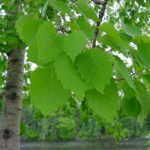bigtooth aspen (Populus grandidentata)
Family: Salicaceae
Categories |
Images |
|---|---|
| Form:
This tree is medium sized reaching 60 to 70 ft. in height and 1 1/2 to 2 ft. in dbh. It also has a straight bole and a thin, irregular crown. |
|
|
Leaves: Shape: broadly ovate; short pointed tip Margin: coarsely serrate Texture: tomentose Variation: N/A |
|
| Bark:
The bark is thin, smooth and greenish in color. It later becomes dark brown with an orange tint and furrowed with flat ridges. |
|
| Twigs and Buds:
The twigs are dull, stout, and grayish-brown in color. The buds are pubescent with a gray to reddish-brown color. |
|
| Flowers and Fruit:
The flowers are dioecious and appear in catkins. The fruit is long and conical. |
|
| Distinguishing Characteristics:
The tree has a straight bole, distinctive leaves, and grayish-brown twigs with pubescent buds. |
|
| Range:
This species occurs in the Great Lakes area. |
|
| Silvics:
This species occurs on sandy upland soils and on more nutrient rich sites compared to trembling aspen. It is often found among northern red oak, white oak, and white pine. |
|
| Ecological and Cultural Importance:
The wood is used primarily for pulp and particle board. Wildlife love foliage, twigs and buds. Young stands are perfect for ruffed grouse and woodcock habitat. |


